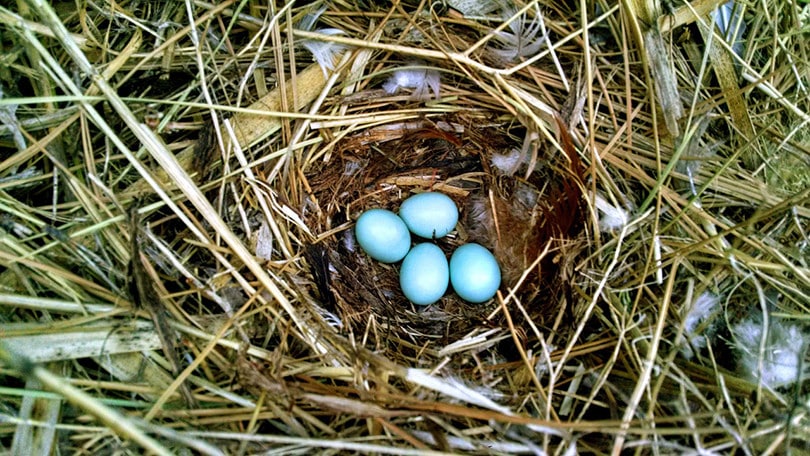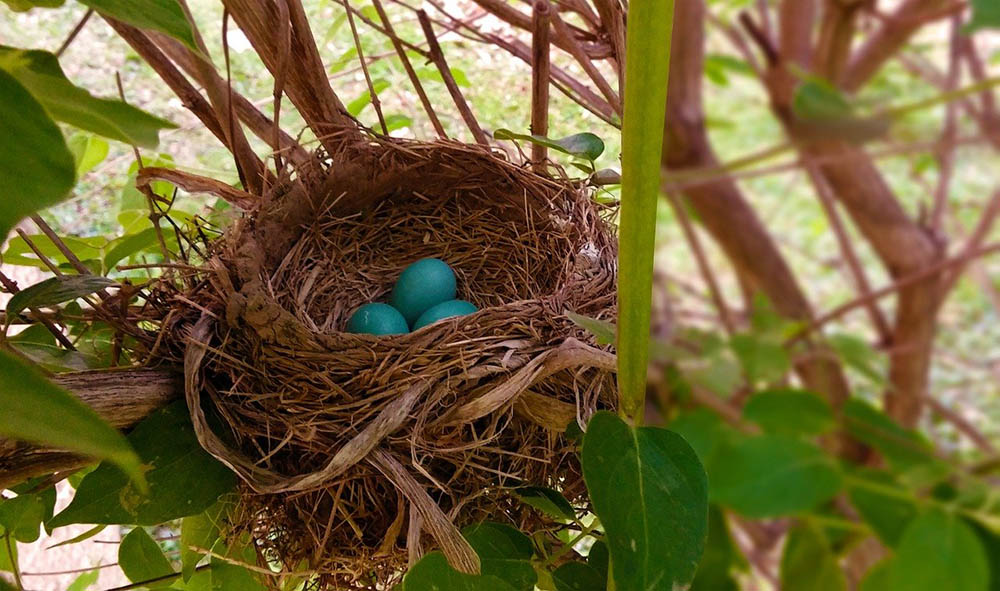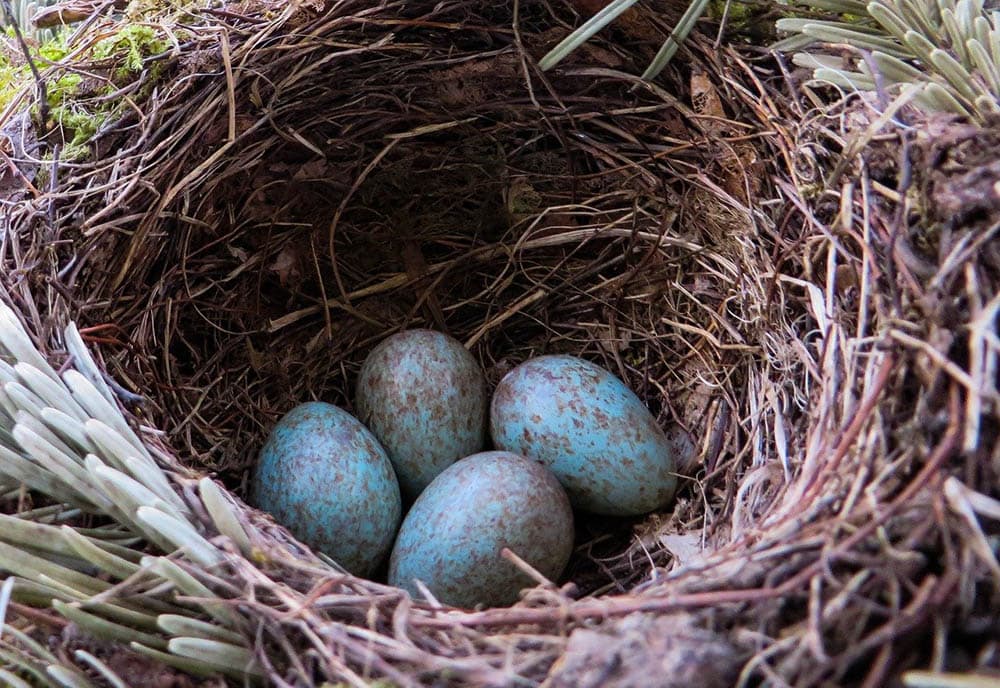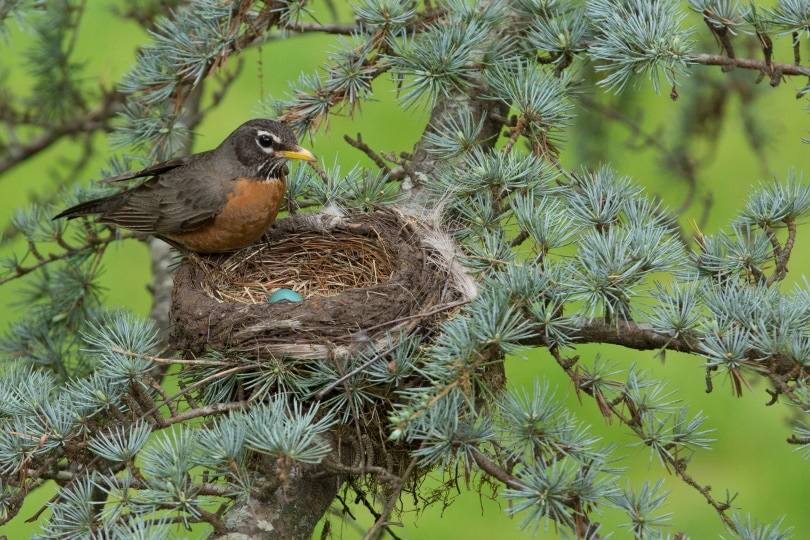Where & When Do Robins Lay Their Eggs? What to Know!
Last Updated on

Compared to other birds, robins are among the most intelligent species on the planet. They’ve always proven to us that they have an impressive capacity for learning and possess prodigious memories.
During the breeding season, we’re used to seeing birds wake up very early in the morning to lay eggs. Not the robin, though. She’ll first look for something scrumptious to fill her belly.
By the time they are done hunting earthworms and feeding, it will be mid-morning.
It’s their way of reminding us that the early bird catches the worm, and those that decide to lay eggs before doing anything else, miss out on such opportunities. Their ideal nesting site is a fully concealed cavity. So, if you’ve been searching for her nest, check the nooks and crannies.
In short, robins lay their eggs in small cup-shaped nests near the ground, and their nesting season is typically March through June.

How many eggs do robins lay?
The bird’s female reproductive system differs greatly from that of a mammal. While we have two functioning ovaries, the robin—just like all the other bird species—only has one.
Her system has been designed to release only one egg per day, and the largest yolk always gets expelled first. It will leave the ovary and move down the oviduct to the bird’s body’s exterior.
At this point, the female has already mated with a partner, and the yolk is fully fertilized. If she wasn’t lucky to find a mate, she will still lay the egg, but it won’t hatch for obvious reasons.
The minute the oviduct realizes that there’s a yolk about to pass by, it will release the protein albumen fluid—known as the egg white. That fluid will encase the yolk as it moves through the duct and be covered with calcium compounds at the very end. But before the robin lays the egg, the compounds will harden to become a shell.

What’s the average clutch size of a robin?
If the conditions are right, the robin will lay three to four eggs. However, if for some reason an egg goes missing, she will lay a replacement. And even a sixth egg, if that goes missing again. She’ll only stop if she has the right number.
To prevent the rest of the eggs from growing, the female will ensure they stay cool. They’ll only be given the warmth they deserve once she’s totally sure she has the right clutch size. That’s why robin babies always hatch at the same time.
By the way, robins are great architects when it comes to building nests. Their structures are often cup-shaped, sturdy, and comfortable. They rarely pick nesting sites that are way above ground, as that would expose them to flying predators such as the hawk.

What’s a robin’s incubation period?
When it’s time to incubate, the female will start to sit on the eggs in the evening. And she’ll do that for the next 12 to 16 days, unless something or someone spooks her, and interrupts the process. They are usually so committed that they won’t leave that space for more than 10 minutes, even if the weather is warm.
Keeping the eggs warm is the chief responsibility of the female. She has to turn them a couple of times every day to ensure all eggs maintain the right incubation temperatures throughout that period.
It’s not an easy task. You’ll spot her standing on top of the nest’s rim, and using her bill to gently roll over each one of them. That process also guarantees that no prospective hatchling will cling onto the shell’s interior walls while developing.
The average body temperature of the robin is 40 degrees Celsius. But some ornithologists believe it could be higher than that, especially during winter. Because birds’ feathers act as inherent insulators, preventing the efficient redistribution of heat, they evolved to create something called the brood patch.
If you take a quick look at their underside, you’ll be able to see a patch of featherless skin that maintains contact with the eggs at all times. And to prevent any heat from escaping, they’ll expose their outer feathers.

How does the robin chick break out of its shell?
Ribins are born with what we call the egg tooth. It’s strong enough to help the chick break a hole and use that space to force itself out. More often than not, they come out in the order in which the eggs were laid. So the first hatchling to break out of its shell will probably be the first egg that was laid.
They will still depend on their parents as they’ll be too weak to forage or hunt for food. Also, they need warmth considering they normally hatch naked. After 3 days you’ll start seeing feathers. The eyes will partially open on the fifth day and fully open after a week or so. The flight feathers grow last.
Since the babies are supposed to be fed 40 times a day, both mom and dad will have to work in shifts to ensure no chick sleeps hungry. They’ll do that for 13 days because that’s when the young ones will be ready to leave the nest and explore the world.
According to statistics, more than half of the robins born in the same year don’t survive the wild. They eventually end up on a predator’s plate or die due to illness. But the good news is that the few that survive successfully breed the following spring.

When do robins nest?
Robins are an enigma because they don’t like to be rushed when it’s time to lay eggs, but will be ready to build their nests as early as January. The nesting season for most birds is expected to start around March and end in June. What makes this whole thing weirder is the fact that those nests will stay empty until mid-April when they start laying their eggs.
How do you know a robin is ready to nest?
The telltale signs are the materials that they’ll start gathering. They’ll need moss, leaves, and maybe even grasses to build a solid nest. Just don’t go too close to the nesting site or let it spot you. If it senses that the site has already been compromised, it will abandon it without thinking twice, and never return.

Is there a way you could help build the nest?
Well, you could supply natural fibers, if you have some. And make sure they are close to a perching zone, so that they can quickly pick up whatever they need and fly back to the site. Or you could place a nesting box in a secluded area, next to a bird feeder. We’re sure a breeding pair will show up in a day or two and mark that territory as theirs.

Conclusion
Did you know the robin’s eggs are blue in color? And we’ve been told by experts that eggs that have darker shades have healthier babies in them.
Before we sign out, there’s a rumor that we would like to put to rest. Some people believe that touching a hatchling or an egg will compel the mom to abandon the nest and everything in it. That’s not true, as their maternal instincts are too strong to let that happen.
Featured Image Credit: donwhite84, Pixabay
About the Author Robert Sparks
Robert’s obsession with all things optical started early in life, when his optician father would bring home prototypes for Robert to play with. Nowadays, Robert is dedicated to helping others find the right optics for their needs. His hobbies include astronomy, astrophysics, and model building. Originally from Newark, NJ, he resides in Santa Fe, New Mexico, where the nighttime skies are filled with glittering stars.
Related Articles:
When Were Binoculars Invented? History, Today & Future
10 Types of Hummingbirds in Arkansas (With Pictures)
8 Types of Hummingbirds in Nebraska (With Pictures)
5 Types of Hummingbirds in Idaho (With Pictures)
3 Types of Hummingbirds in Mississippi (With Pictures)
8 Types of Hummingbirds in Kansas (With Pictures)
5 Types of Hummingbirds in West Virginia (With Pictures)
5 Types of Hummingbirds in Ohio (With Pictures)
